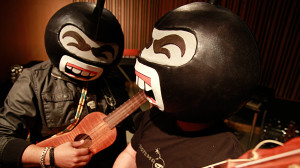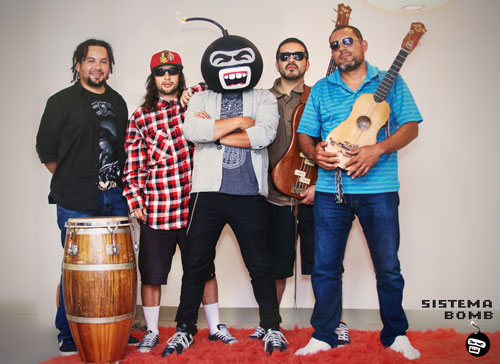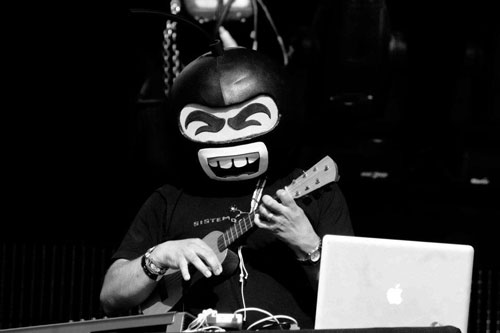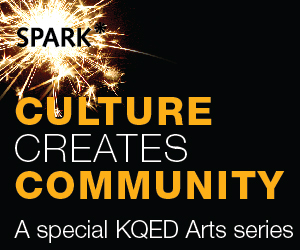Traditional Mexican Music Gets a Jolt of Electricity

Traditional Mexican Music Gets a Jolt of Electricity
You might be familiar with the 1958 Ritchie Valens song, “La Bamba.” But what you might not know is that this song comes from a very old Mexican musical genre, the Son Jarocho. Born of conquest and slavery, Son Jarocho is a traditional music from the Mexican state of Veracruz that mixes African, indigenous, and European influences to produce a truly American sound.
Right now, that music is being transformed, inspired in part by a new generation of California musicians.
One of those musicians is Hector “Hecdog” Perez. At his San Francisco studio, he sits at a control panel that looks a little like it belongs at NASA headquarters, pushing buttons and watching a display of sine waves bounce up and down on a big screen in front of him. But instead of launching a rocket, he’s setting off a bomb: Sistema Bomb.
“It’s a lot like what New Orleans is here because it’s a port city,” Perez explains. “The histories are combined in the way the people dress, the way they speak, in the poetry, in the food and in the music.”Sistema Bomb is a music project, and Perez is its creator. He’s bringing an electronic sensibility and a California perspective to the music of Son Jarocho. The genre is no stranger to adaptation. Its epicenter is the city of Veracruz, Mexico, one the oldest ports in the Americas. It’s where Hernán Cortés first landed on his conquest of Mexico back in the 1500s, and it became a gateway for slavery, colonization and trade.

People from all over the world mixed together, and you can hear all those influences in the Son Jarocho sound. It’s a sound that Perez has been listening to most of his life. He first heard the music as a kid growing up in South LA. “My parents are from Jalisco. I grew up listening to cumbia as well as Son Jarocho, as well as hip hop, as well as reggae, classical music and jazz,” says Perez.
https://soundcloud.com/sistema-bomb/sistema-bomb-la-gallina
But as he got older, his interests shifted. He studied electronic music at UC Berkeley, went on to a gig at A&M Records, and founded his own production company, Music Orange. He makes music for commercial clients like Apple, Sony, and Yahoo. But it was a Los Lobos song, “La Guacamaya,” that took him back to his roots. “When I heard that song, that requinto that David Hidalgo was playing, I just wanted to know what that was,” Perez says.
The requinto is a melodic guitar, one of Son Jarocho’s central instruments. And the sound of that guitar took Perez on a musical journey, one that melded tradition with technology, and led to the creation of Sistema Bomb’s first album, Electro-Jarocho, a groundbreaking record that got nominated for a Grammy in 2013.
Perez is now hard at work on a track for Sistema Bomb’s second album, due out later this year. It’s called El Camotal. Perez’s version also features Afro-Latin jazz percussionist John Santos, and Ozomatli’s Asdru Sierra. But it’s Perez’s palette of digital beats and electronic tones that brings it to life.

Fans and traditionalists might wonder if the Son Jarocho actually needed this jolt of electricity.
Marco Villalobos spent time in the studio during the making of Sistema Bomb’s first record. He’s producing a documentary film called Beyond La Bamba, about Son Jarocho’s roots. He says he’s hopeful that Sistema Bomb will bring new audiences to a vibrant traditional music. “I think Sistema Bomb is playing with a new type of digital instrument and effect process and coming up with something slightly new, and that’s always refreshing,” says Villalobos. “If you can trace that back to where it comes from, which is a traditional rustic raw Son Jarocho from the campos of Veracruz, I think that’s even better.”
Villalobos says the audience for traditional Son Jarocho has always been limited, partly because the genre doesn’t always translate to a mass audience. “It’s not a radio thing. You’re not going to get airplay. Which is the cool thing about Sistema Bomb, I think I’ve heard it on the radio!” he says.

The Sistema Bomb sound has caught on both in the US and in Mexico. “What was surprising is that it was done by someone outside of Mexico,” says Perez. “I’ve gotten so many comments where they were saying ‘wow, you made me see my own genre in a whole new way’ and it’s super cool. You can rediscover the music.”
But Perez says respect for Son Jarocho is at the heart of what he does. “The intent was not to modernize the genre as if I felt the genre is caught in some Stone Age state. It was simply a celebration of the genre through my lens,” says Perez.
It’s a lens, he says, that brings audiences — new and old — to a sound that’s been there all along.

Funding for KQED Arts is provided by The William and
Flora Hewlett Foundation. Support is also provided by the members of KQED.



